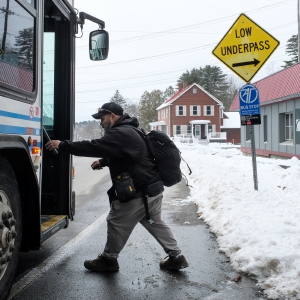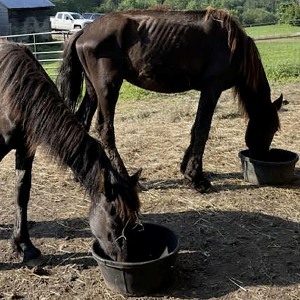50 Years Later, a Hike to a Deadly Plane Crash Site Still Has a Lot to Teach
| Published: 10-14-2018 12:03 AM |
Etna
Yet plenty of scars remain from Northeast Airlines Flight 946’s crash on Oct. 25, 1968, that killed 32. Those scars extend to a group of eerily discolored rocks that Jeff Rapsis — son of the flight’s pilot, John Rapsis Sr. — considers ground zero for the incident. The ledge rock protruding from Moose Mountain’s soil about 50 feet below its south summit remains tinted a Mars-like red in some areas and charred pale gray or black in others, which Rapsis attributes to immeasurable heat levels following the plane’s explosion.
“This is where the nose landed,” Rapsis said to a group joining him for a hike to the location in raw, low-visibility conditions on Saturday, weather not unlike that which likely exacerbated the plane’s problems that day. “These rocks aren’t supposed to look like that. Their geology is changed forever.”
So, too, were the lives of families involved in the crash, including those of 10 survivors who were seated in the tail section of the plane and spared incineration, unlike those in its fuselage. The lasting impact of the crash was a focal point of Rapsis’ slideshow presentation and discussion at Lebanon Municipal Airport’s Granite Air Center before the hike to mark the upcoming 50th anniversary of the crash.
Newspaper clippings were on display — the incident dominated the front page of the Boston Globe, Nashua Telegraph and many more — and copies of the National Transportation Safety Board’s 60-page accident report sat in a neat pile. Those accounts for years were all Rapsis had to learn of the incident, which occurred when he was 4 years old. He ventured to the site for the first time near its 25th anniversary in 1993.
“Everything I read talked about how remote and rugged the terrain was, so in my mind, for the longest time, I envisioned something like the north pole or the Yukon Territory,” Rapsis told a group of about 40 gathered for the event in Granite Air Center, adjacent to the runway where Northeast Airlines’ twin-engine “Yellow Bird” Fairchild-Hiller 227 was supposed to land that night before it continued to Montpelier. “It might not have been quite like that, but it was very difficult terrain to navigate for the survivors and for those involved in the rescue effort, to be on those mountain ledges after dark.”
A handful of those who were on the scene attended Saturday’s presentation, including Charlie Garipay, then a member of the Hanover Fire Department, and Bob Colburn, who worked for the Etna Fire Department at the time. Garipay helped extinguish sporadic fires peppering the landscape before helping to create a would-be helicopter landing zone on the Dartmouth green, intended to receive the wounded for transport to Mary Hitchcock Memorial Hospital.
The landing zone was never used because rescuers on Moose Mountain couldn’t clear a landing area there by the time a helicopter arrived.
Article continues after...
Yesterday's Most Read Articles
“We went up from the Enfield side, and it was pitch black,” Colburn recalled. “Richard Baughman, a physician, was in my group. We got all the way to the top, and someone handed me an ax and said, ‘Start chopping trees!’ We got a pretty good area cleared, but it wasn’t big enough.”
During the question-and-answer portion of the event, Hanover resident Dwight Aspinwall asked Rapsis about his knowledge of survivors following the tragedy. Rapsis spoke of a young stewardess on the flight, Betty Frail, who survived the crash and went on to earn a medical degree at Tufts University, only to die of breast cancer in 1982.
“She only lived to her 30s,” Rapsis said.
Another survivor, a Texan named Calvin Osha, for years made a habit of calling Rapsis at Christmastime to reiterate that he didn’t blame his father for the crash.
While the official probable cause in the accident report is “the premature initiation of descent,” there were indications of radio signal interference and the need for additional navigation facilities at Lebanon Airport at the time.
“This was a period when there were five (Northeast Airlines) crashes in recent years, and it was not uncommon to see life insurance kiosks at airports,” said Rapsis, who is the executive director for the Aviation Museum of New Hampshire in Londonderry. “It was an inadequate navigation system for the conditions and the terrain. Airlines were still learning how to fly well in adverse conditions and weather.”
About 20 people joined Rapsis and his two brothers, John Jr. and Jason, for Saturday’s rainy ascent to the crash site. Some, like Hanover residents Joe and Judy Danna, regularly climb Moose Mountain, have known about the crash for years and were eager to learn more about its history. Cathy Marshall traveled from Charlotte, Vt., with her family for the occasion.
“My husband’s father (Sam Zappala) was part of the rescue effort,” said Marshall, accompanied by her fox hound, Shea, at Moose’s summit while her son, Lincoln, explored the crash site. “Lincoln has always been very interested and always saying, ‘Can we go someday?’ So we couldn’t pass this up.”
Jeff Rapsis at first hesitated to organize an event memorializing the 50th anniversary of Flight 946’s demise, fearing it may be perceived as a sort of unwarranted celebration given the suffering it caused to so many. But he considers talking about the crash to be important for those affected, including himself.
“I think of it like going to a cemetery on Veterans Day or Memorial Day,” Rapsis said during the hike. “Closure can take a long time, and sometimes it never ends. What happened isn’t at the surface of my mind every day, but it’s always part of me in some way. Sometimes it’s good to bring these things back to the surface. It helps you grow as a person.”
Jared Pendak can be reached at jpendak@vnews.com or 603-727-3216.

 Upper Valley winter shelters kept dozens warm and dry
Upper Valley winter shelters kept dozens warm and dry Owner of Friesian horse facility ordered to pay care costs for seized animals
Owner of Friesian horse facility ordered to pay care costs for seized animals
